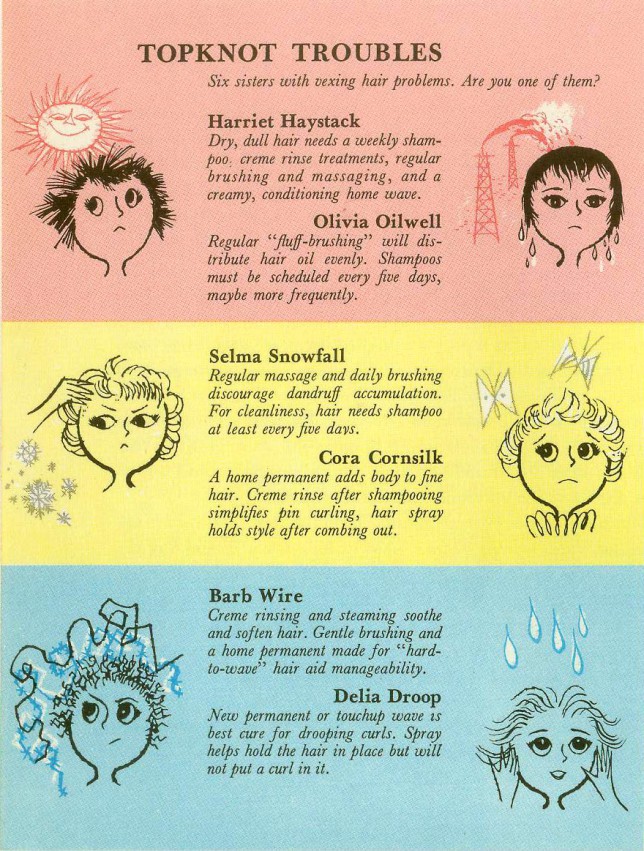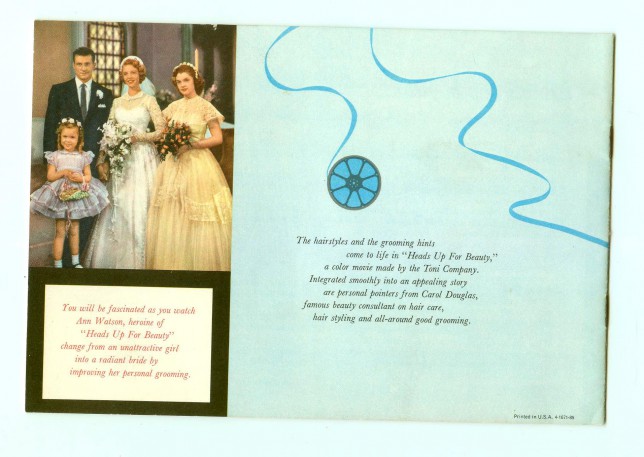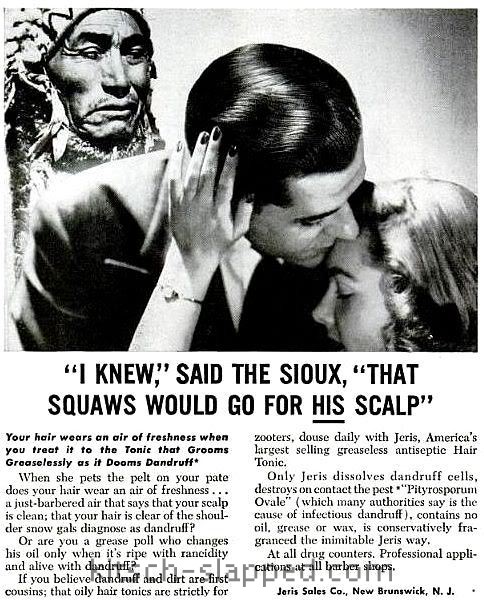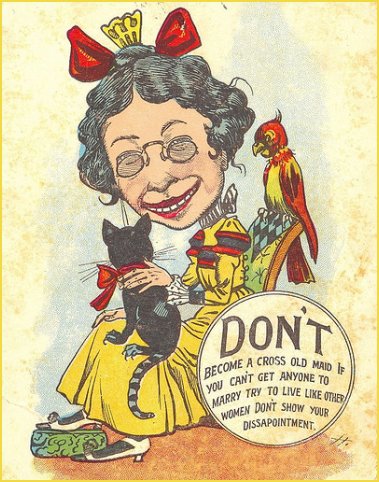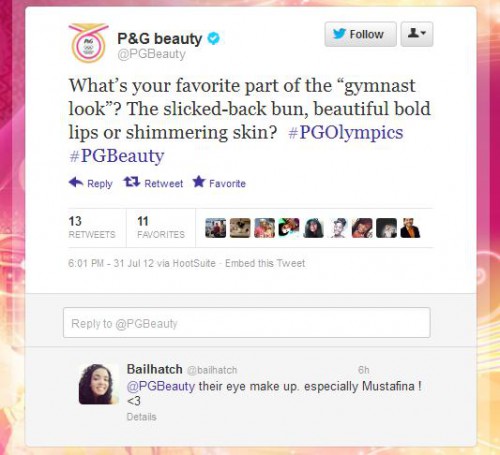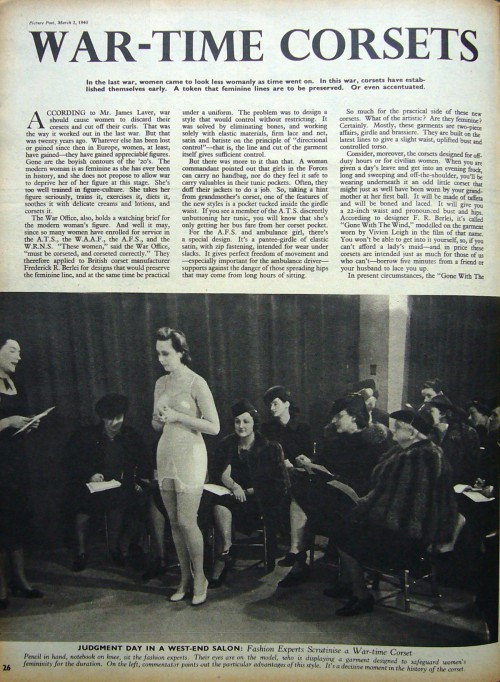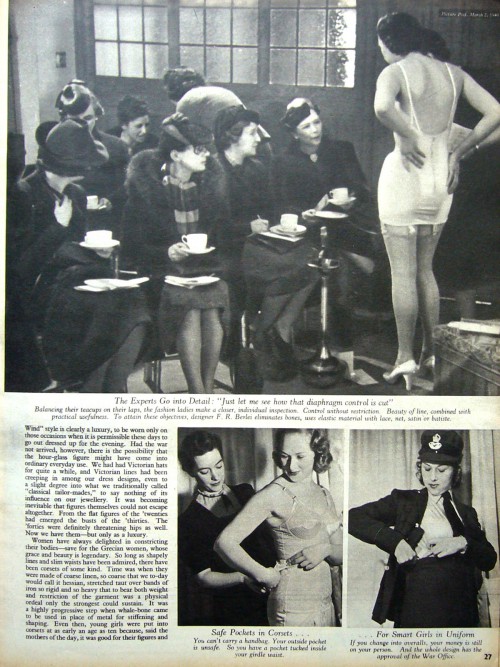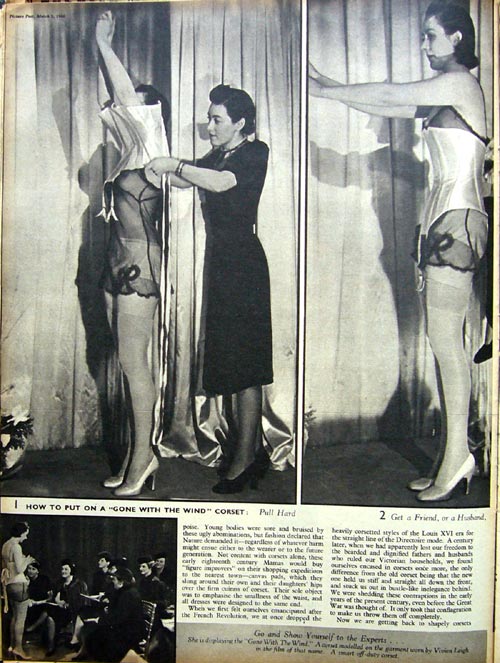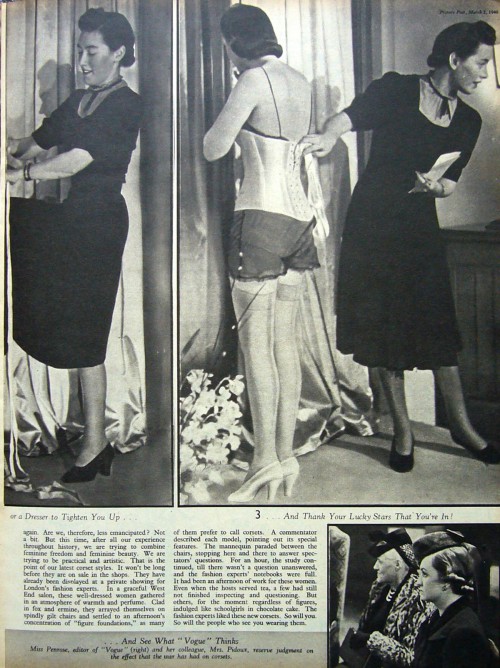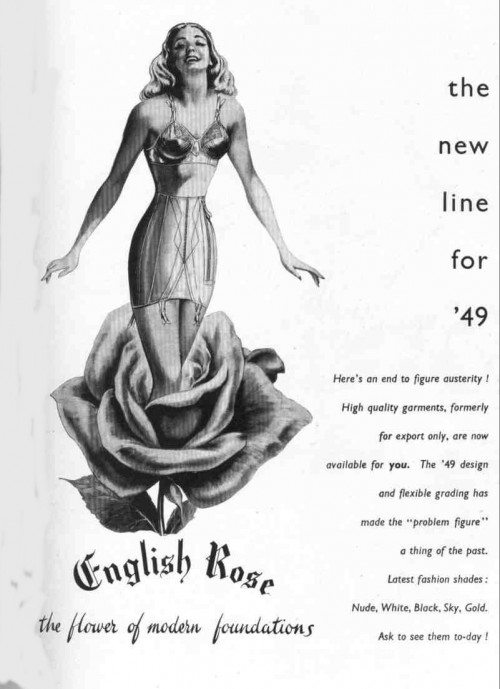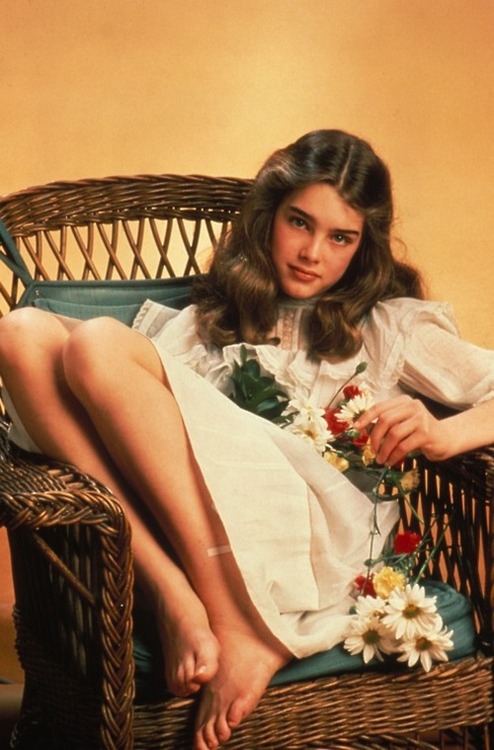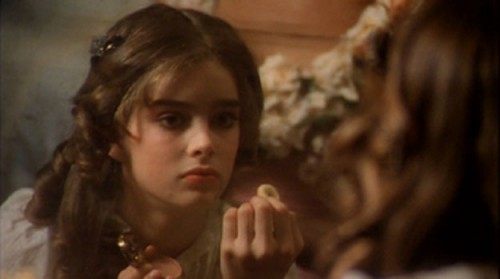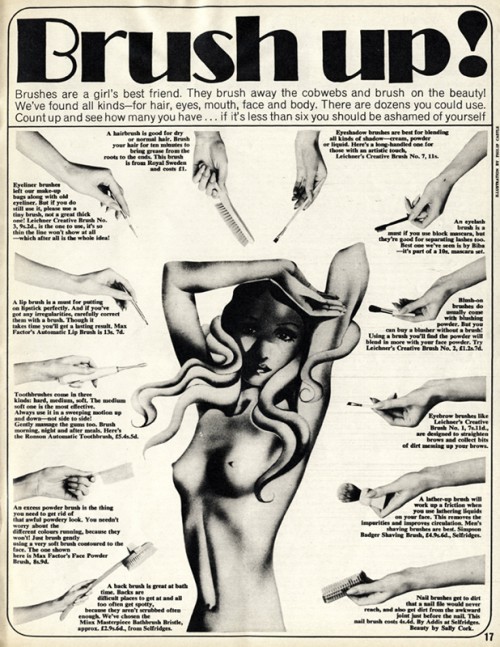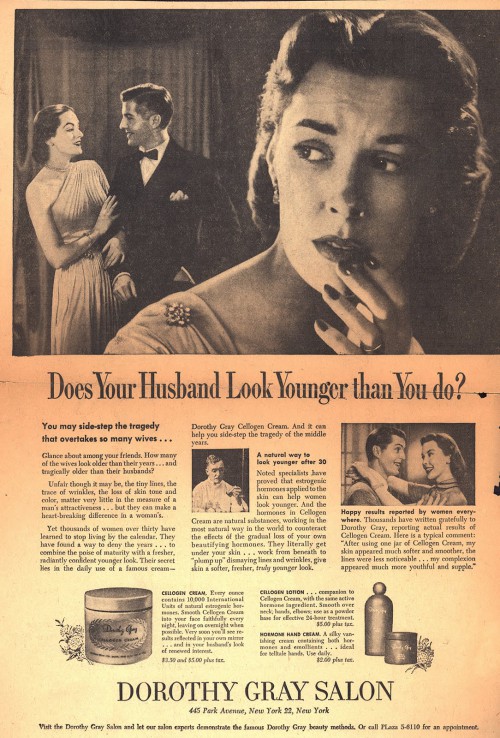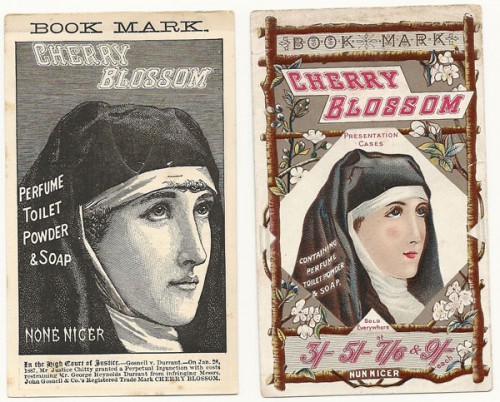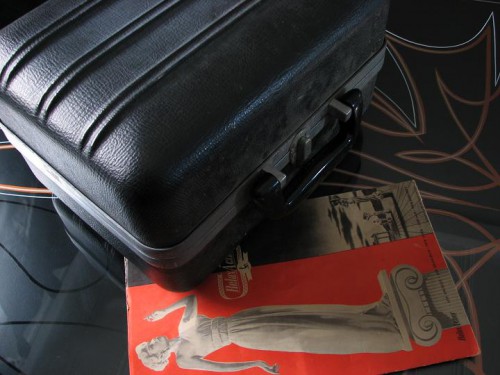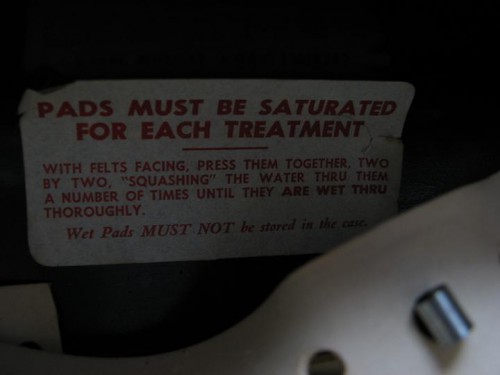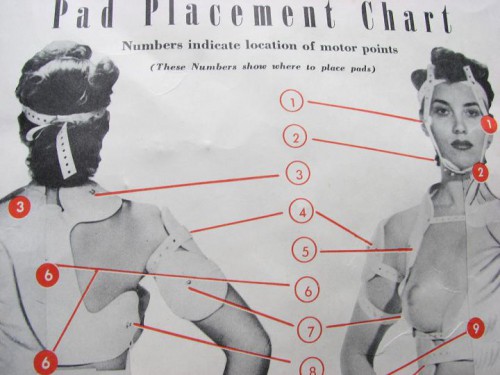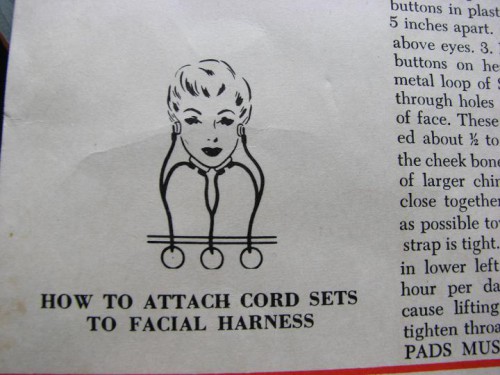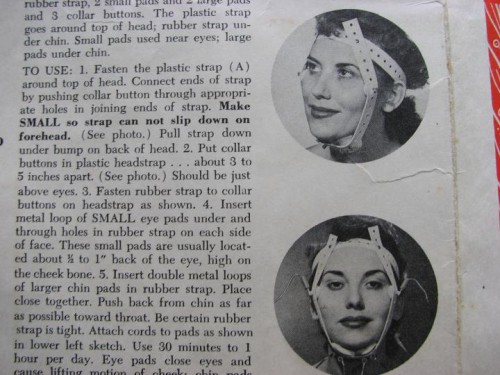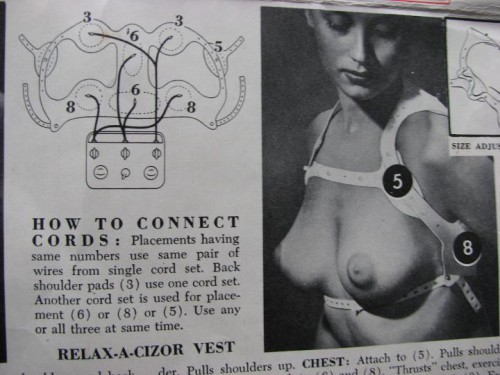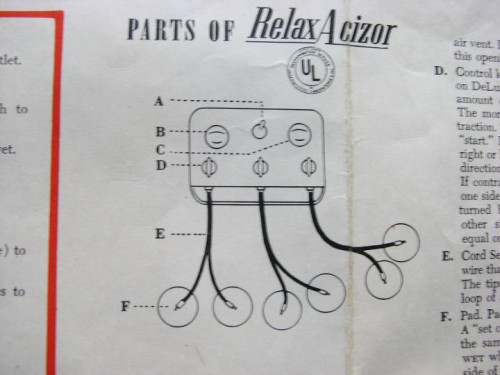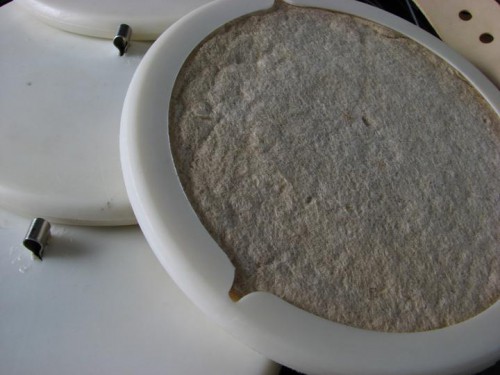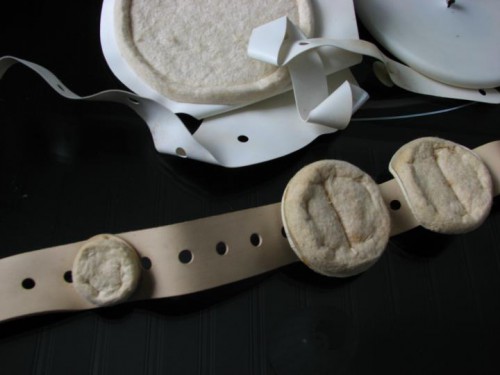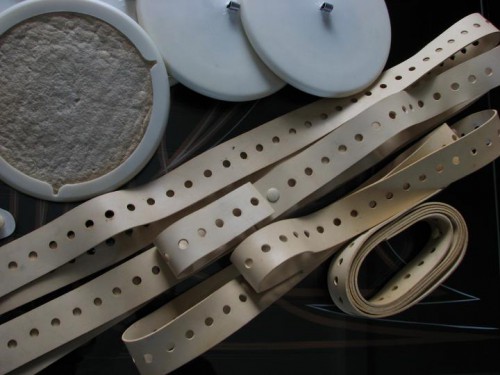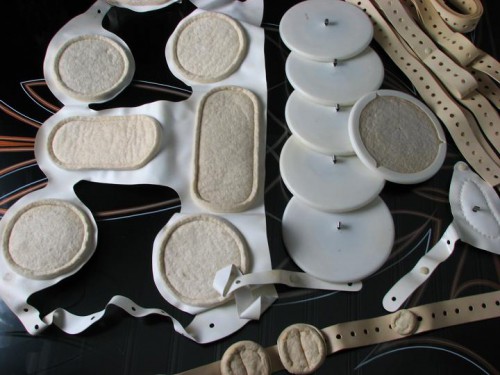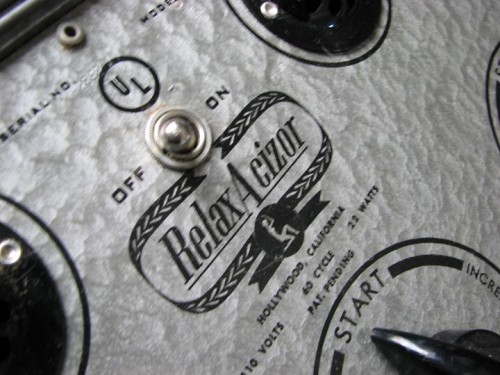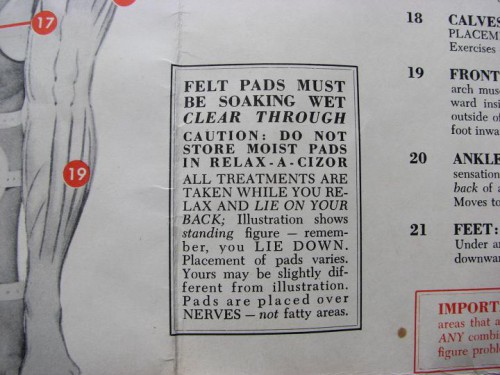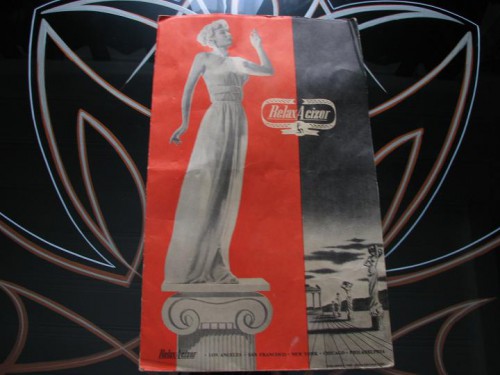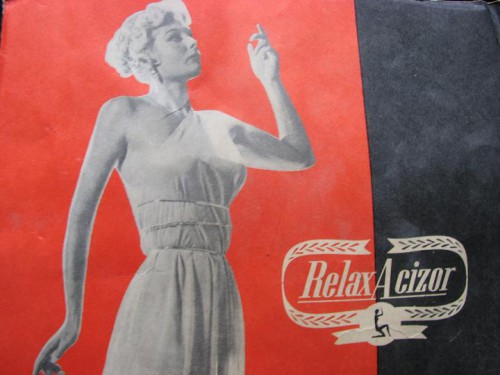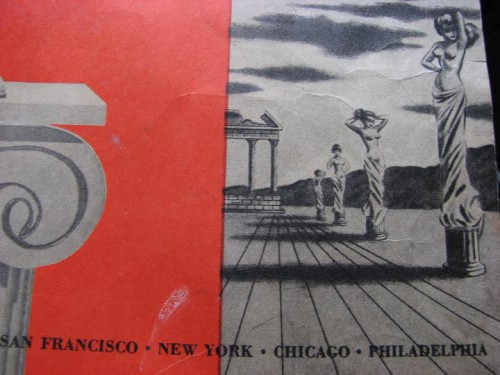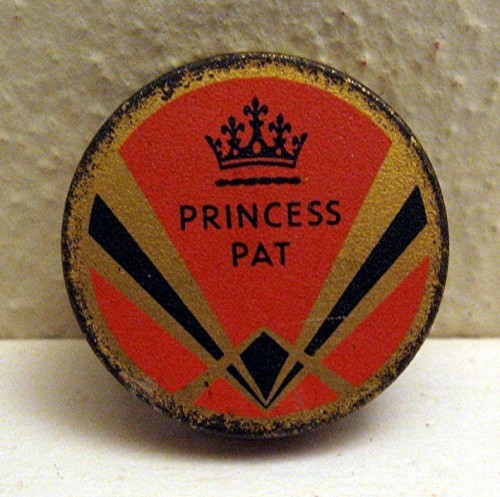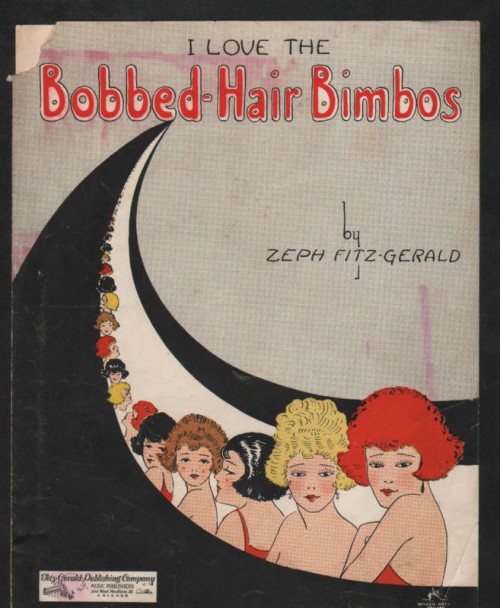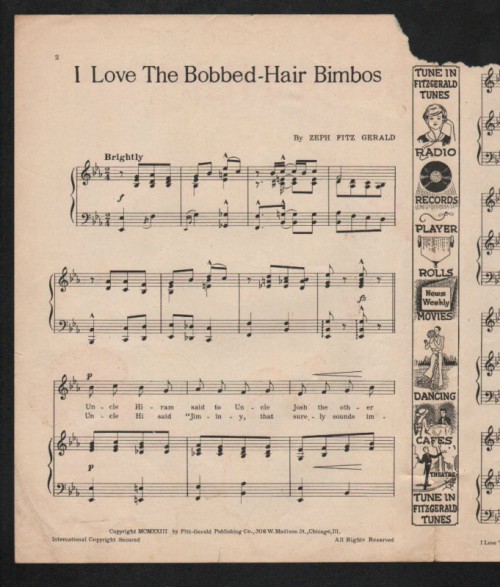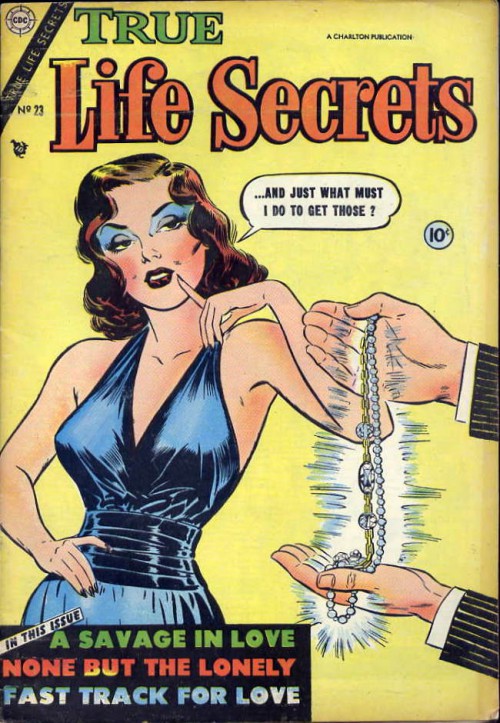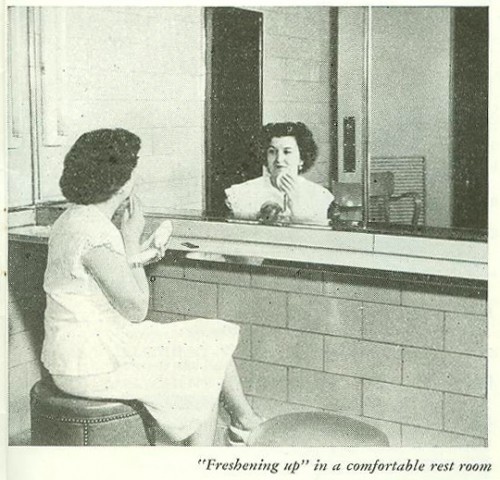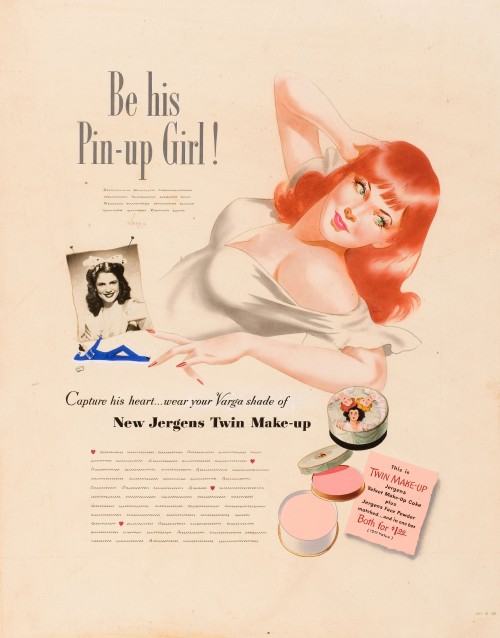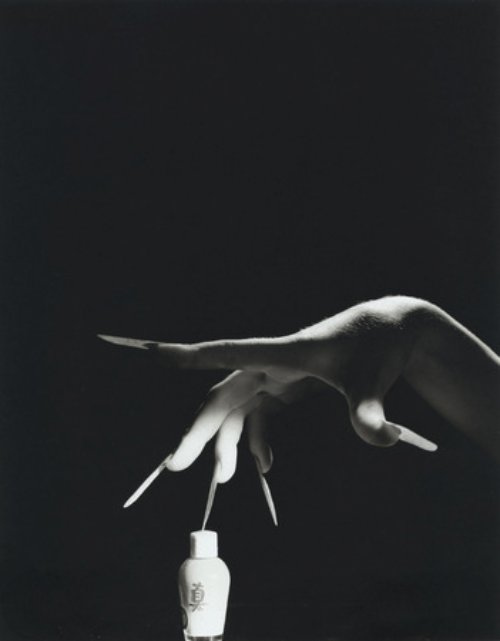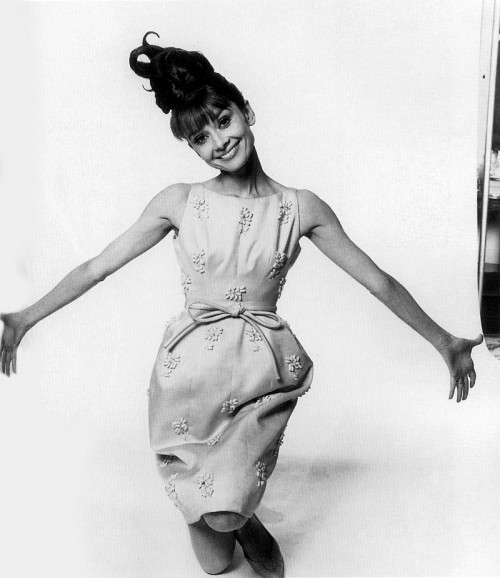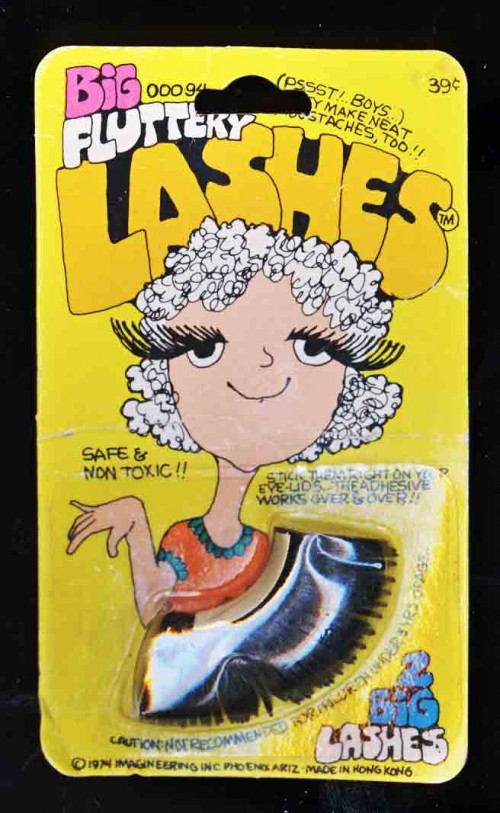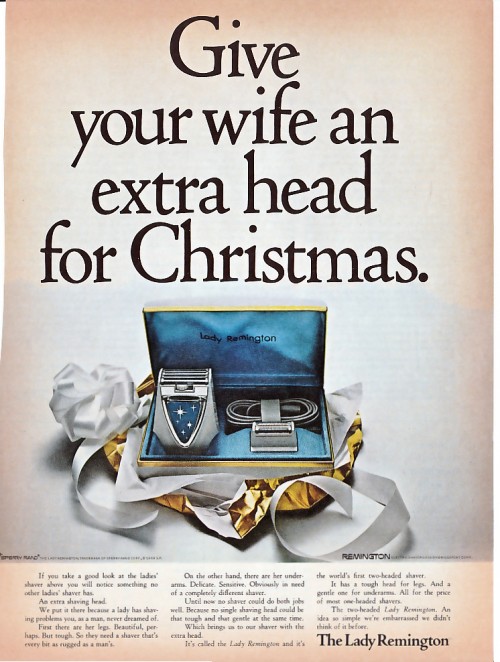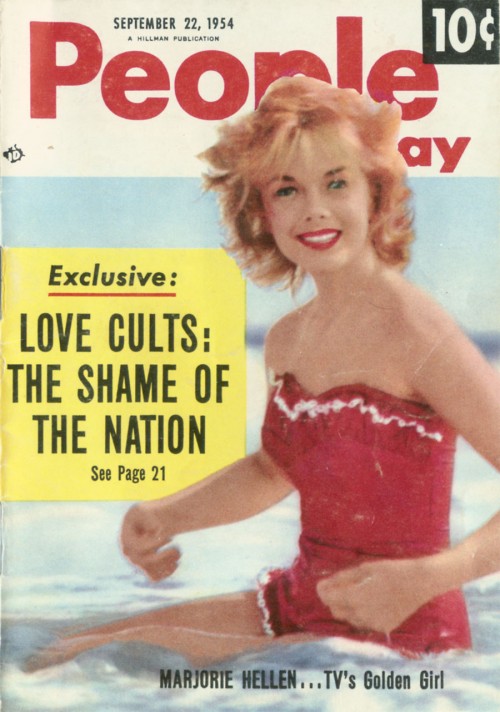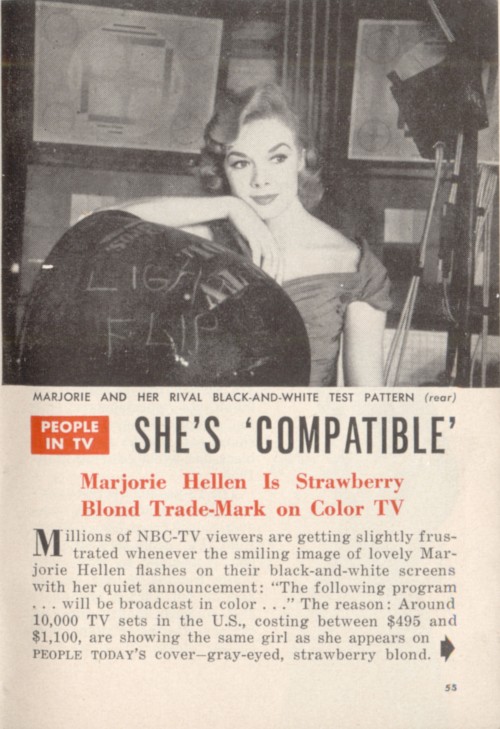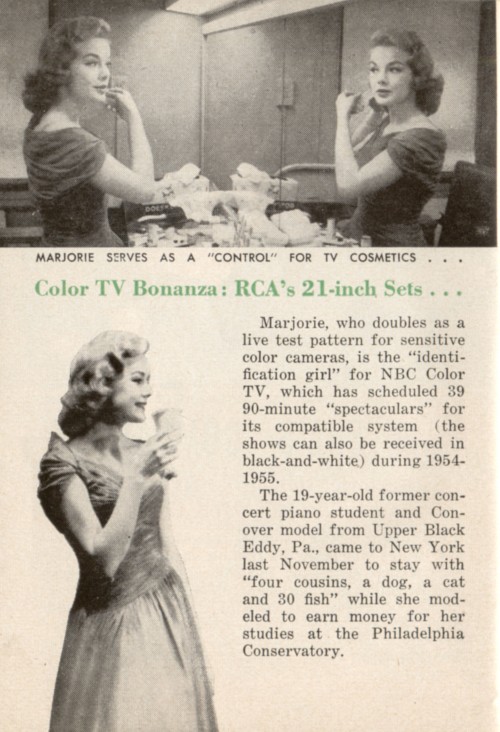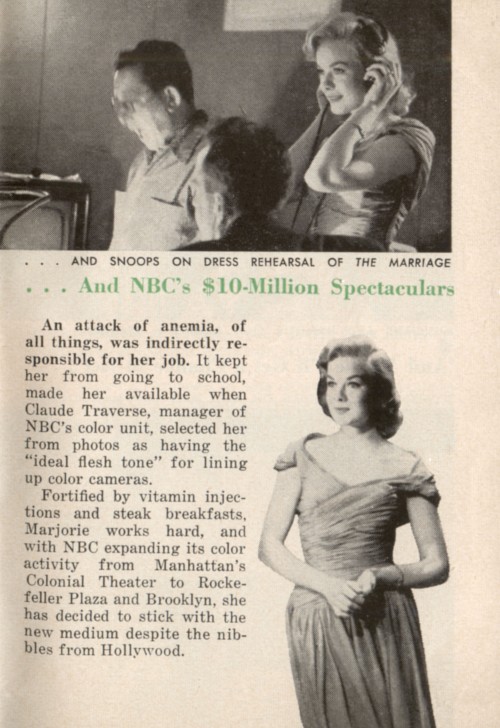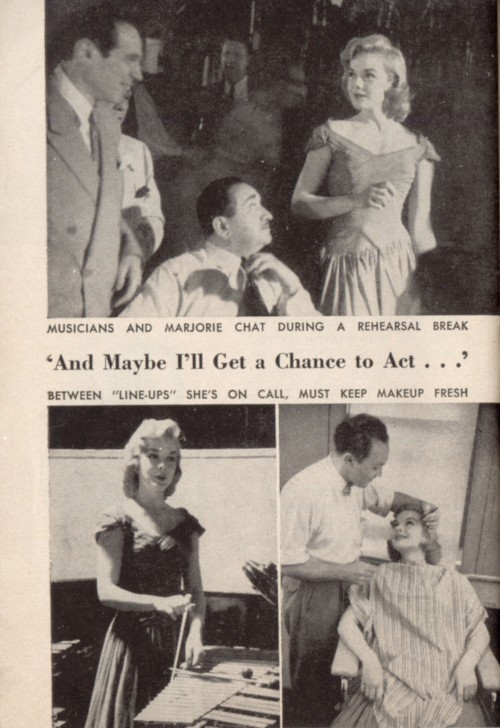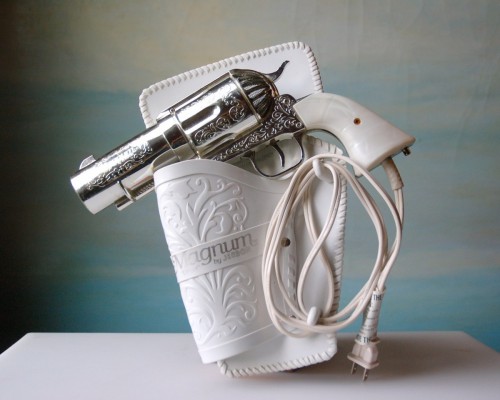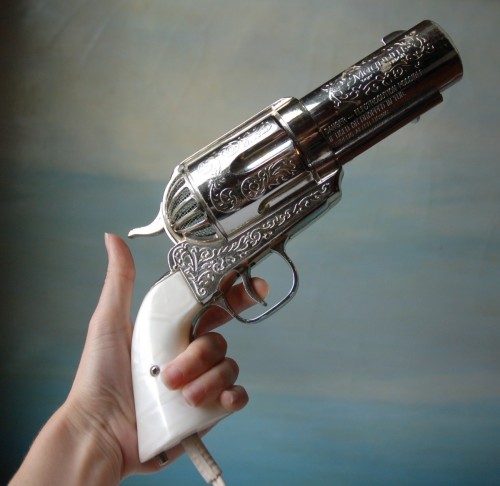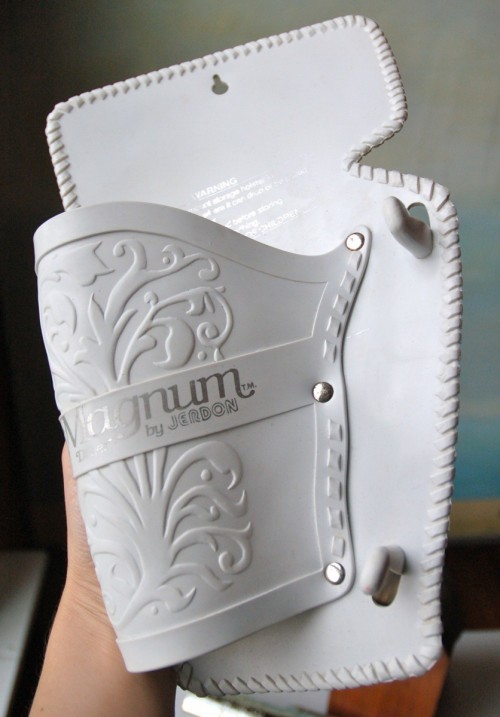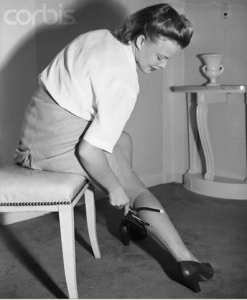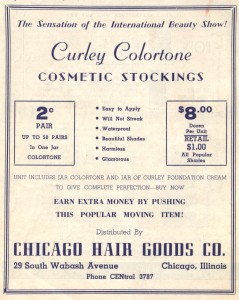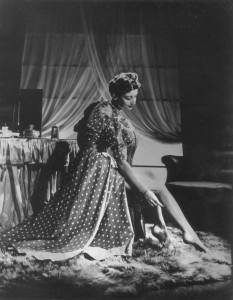I found this rather spectacularly mod commercial for Yardley’s Slicker Dollys Bus Lipsticks while researching this vintage lipstick tube. (Found via Kate Baird’s Yardley Pinboard.)
Tag: beauty
“Topknot Troubles”
If you collect vintage magazines and ephemera like I do, you know there’s nothing new under the sun. The celebrity names & faces change, there’s “modern” graphics and trends too. But the push on beauty and grooming products remains true. This little bit comes from Beauty On A Budget, a promotional piece for hair & beauty products (copyright 1957 The Gillette Co.). The illustrations may be period, and the kitschy-cute names too, but the tips on treating your hair problems are rather straight out of any beauty column today. Meet Harriet Haystack, Olivia Oilwell, Selma Snowfall, Cora Cornsilk, Barb Wire, and Delia Droop — “six sisters with vexing hair problems.”
Despite their hair problems, most if not all of the sisters must have gotten married as they all have different last names! Perhaps that’s because they were lucky smart enough to watch Gillette’s helpful film, a Toni Company’s color movie entitled Heads Up For Beauty. It included pointers from “famous beauty consultant” Carol Douglas — and those pointers helped Ann Watson “change from an unattractive girl into a radiant bride by improving her personal grooming.” One prays to the YouTube gods for someone to find and put this movie up online.
Bad Hair Is No Joke (Or, Hairy Situations In Racism & Misogyny)
I have not been doing a lot of “link round-up” posts since I’ve been curating at Scoop.it, but sometimes I will still find a thing or two which will spawn so many quick thoughts that it seems best to fire all the rounds in one quick-draw post. That’s certainly the case today as one vintage image and one blog post have me quickly shooting from the hip.
Via this post at Doc Blue’s Bullshit Emporium, I found this vintage ad for Jeris Hair Tonic at Retro Adverto. Along with the horrid ad copy, there’s the racist and gender obscene headline:
“I Knew,” Said The Sioux, “That Squaws Would Go For His Scalp”
I don’t know that I actually have to beat all the dead horses in this vintage ad, do I? With so much horribleness going on, it’s hard to imagine that Jeris would survive; but the company — and it’s hair tonic — is still around today. I do hope they die a little on the inside whenever this ad is resurrected.
While we are on the subject of hair…
Lip Mag has a piece on hair: crowning glory: hair, sex and gender. My profound dislike for the absence of capitals in headlines aside, the post is rather provocative and worthy of a good read. However, it is a bit incomplete. I don’t think it is proper to discuss or rant about such things as “long and blonde” being the ideal femininity standards for women’s hair without pointing out that there are some biological reasons for this.
Often, “beauty” is really just about genetics, healthy children, and the survival of the species. Long hair is a sign of health, and health is genetically preferred. Lighter hair, especially blonde hair, is often an indicator of youth and therefore fertility. The fair skin which typically, naturally, accompanies the blonde hair also makes it easier to see signs of disease, infestation, infection, and the like. Such blemishes are signs of genetic weakness, aging, or other potential problems with the viability of offspring. This is all hardwired into humans biologically. It’s primal evolution. This is why fake blondes enjoy the same attention as natural blondes; for even when everyone knows they’re seeing a bleach-bottle-blonde, the sight triggers an unconscious response of, “Yes, this is preferred genetic material.” This biological drive is what is sets many “beauty standards”. And since blondes, especially the light-white-skinned and blue-eyed variety, are fewer in numbers, their rarity is akin to “coveted and collectible”. [After decades of hair styles, lengths, and colors I know (NWS) that blondes do have more fun — if by “fun” you mean “attention.” Not all of it positive, either; especially when the attention is from other women (NWS). Women hating or deriding blondes, real or fake, is like any other body shaming issue and should be stopped.]
While genetics and evolution are typically not conscious thoughts in the process of calling someone “beautiful” or “attractive”, there are many recorded acts of using beauty standards as markers for desirability in gender and race. From the Bible and organized eugenics programs to the less organized attacks of societal judgements (NWS), history shows that women have been — and continue to be — judged, humiliated, marked, and controlled by their hair.
This brings be back to the aforementioned issue of “scalping” and how I often feel that the current trend in removing the pubic hair of women is not unlike the “pussy scalping jokes” of the past (NWS). It’s not only racist, but all about controlling women and their bodies.
Old Maids
In Reflections: The Life, Writings and History of Geneva Mae Thomas Bridgford (2012), compiled by her daughter, Bonnie Bridgford Good, there’s the story of 18 year old Geneva and her friend going to the big city to attend Miss Brown’s Training School in Milwaukee. The year was 1928, and the two young ladies stayed at the Methodist Boarding School House on 11th and State — under watchful eyes.
The spinster owners of the boarding school took their responsibility of chaperoning the young women quite seriously. The older women at work (ranging in age from 25 to 40) also felt a need to mother them, and warn them of the dangers in the city. As a vent to her frustration, Mother wrote the following poem:
Old Maids
Tell me not in mournful numbers
Of the habits of old maids.
Well I know their every weakness
How their beauty wanes and fades.
They are old, they are ugly
And their hearts though staunch may fail;
For they shake and they quiver at the coming of a male.
They surround me, jeopardize me
These old maids of whom I write.
At my home and at my office
They boss me with all their might.
I’m rebelling, I won’t stand it!
And I’m very sure of this,
If I can prevent it
My name won’t always start with Miss
Female Olympic Athletes Still Have “Beauty” To Hurdle
Today, in honor of the Olympics, in honor of the strong, skilled, and powerful US female gymnastic team, Proctor & Gamble’s official beauty Twitter account tweeted:
What’s your favorite part of the “gymnast look”? The slicked-back bun, beautiful bold lips or shimmering skin? #PGOlympics #PGBeauty
In return I tweeted:
@PGBeauty Really? Beauty looks based on female gymnasts? Are you going to do this sort of thing to male athletes?
No one responded. Not P&G; not any of my tweoples.
I guess I should just be glad I wasn’t banned from Twitter for knocking a paying advertiser. But in actuality I’m peeved that no one else seems upset by this… There were 13 retweets, 11 favs, and one comment — not mine (mine is conspicuously absent).
So000 disappointing.
In Older Athletes Earning Gold For Endurance In The Olympics, Patricia Nell Warren writes:
Fortunately for Olympic athletes, they don’t have to rely on their looks to get to the podium, or even get to the Games. However gorgeous their displayed bodies might grow because of intensive conditioning — if they are swimmers or gymnasts or runners — it’s what they can DO with those bodies that counts.
Then there are those, like the fencers and archers and equestrians, who may or may not have a pretty face or gorgeous bods, but who deliver the goods while buttoned up to the chin in traditional gear, even gloves and helmets or top hats, with only their faces visible.
While Warren’s article was about what the LGBT community might learn from events such as the Olympics, it’s clear that “we heteros” have a long way to go ourselves. Some of us are forgetting to honor and admire the dedication, skill, and prowess of our female athletes when there’s beauty standards and products to sell.
Ain’t that a kick in the groin.
War-Time Corsets
This four-page vintage advertorial article, War-Time Corsets, in the Picture Post (March 2, 1940), isn’t just more corset history, but rather shows what life was like on another WWII homefront — not the USA, but in Europe.
Below I’ve transcribed the scans from Vintage Chic; the third page was near impossible to read (somehow scanned/posted at a smaller size), but I’ve done the best I could.
In the last war, women came to look less womanly as time went on, In this war, corsets have established themselves early. A token that feminine lines are to be preserved. Or even accentuated.
According to Mr. James Laver, war should cause women to discard their corsets and cut off their curls. That was the way it worked out in the last war. But that was twenty years ago. Whatever else has been lost or gained since then in Europe, women, at least, have gained — they have gained appreciable figures. Gone are the boyish contours of the ’20’s. The modern woman is as feminine as she has ever been in history, and she goes not propose to allow war to deprive her of her figure at this stage. She’s too well trained in figure-culture. She takes her figure seriously, trains it, exercises it, diets it. soothes it with delicate creams and lotions, and corsets it.
The War Office, also, holds a watching brief for the modern woman’s figure. And well it may, since so many women have enrolled for service in the A.T.S., the W.A.A.F., the A.F.S., and the W.R.N.S. “These women,” said the War Office, “must be corseted, and corseted correctly.” They therefore applied to British corset manufacturer Frederick R. Berlei for designs that would preserve the feminine line, and at the same time be practical under a uniform. The problem was to design a style that would control without restricting. It was solved by eliminating bones, and working solely with elastic materials, firm lace and net, satin and baste on the principal of “directional control” — that is, the line and cut of the garment itself gives sufficient control.
But there was more to it than that. A woman commandant pointed out that girls in the Forces can carry no handbag, nor do they feel it safe to carry valuables in their tunic pockets. Often they doff their jackets to do a job. So, taking a hint from grandmother’s corset, one of the features of the new styles is a pocket tucked inside the girdle waist. If you see a member of the A.T.S. discreetly unbuttoning her tunic, you will know that she’s only getting her bus fare from her corset pocket.
For the A.F.S. and ambulance girl, there’s a special design. It’s a pantee-girdle of elastic and satin, with zip fastening, intended for wear under slacks. It gives perfect freedom of movement and — especially important for the ambulance driver — supports against the danger of those spreading hips that may come from long hours of sitting.
So much for the practical side of these new corsets. What of the artistic? Are they feminine? Certainly. Mostly, these garments are two-piece affairs, girdle and brassiere. They are built on the latest lines to give a slight waist, uplifted bust and controlled torso.
Consider, moreover, that corsets designed for off-duty hours or for civilian women. When you are given a day’s leave and get into an evening frock, long and sweeping and off-the-shoulder, you’ll be wearing underneath it an odd little corset that might just as well have been worn by your grandmother at her fist ball. It will be made of taffeta and will be boned and laced. It will give you a 22-inch waist and pronounced bust and hips. According to the designer F.R. Berlei, it’s called “Gone With The Wind,” modeled on the garment worn by Vivien Leigh in the film of that name. You won’t be able to get into it yourself, so, if you can’t afford a lady’s maid — and in price these corsets are intended just as much for those of us who can’t — borrow five minutes from a friend or your husband can lace you up.
[Bottom Caption: JUDGEMENT DAY IN A WEST-END SALON: Fashion Experts Scrutinise a War-time Corset
Pencil in hand, notebook on knee, sit the fashion experts. Their eyes on the model, who is displaying a garment designed to safeguard women’s femininity for the duration. On the left, commentator points out the particular advantages of this style. It’s a decisive moment in the history of the corset.]
[Caption: The Experts Go into Detail: “Just let me see how that diaphragm control is cut”Balancing their teacups on their laps, the fashion ladies make a closer, individual inspection. Control without restriction. Beauty of line, combined with practical usefulness. To attain these objectives, designer F.R. Berlei eliminates bones, uses elastic material with lace, net, satin or baste.]
In present circumstances, the “Gone With The Wind” style is clearly a luxury, to be worn only on those occasions when it is permissible these days to go dressed up for the evening. Had the war not arrived, however, there is the possibility that the hour-glass figure might have come into ordinary everyday use. We had had Victorian hats for quite awhile, and Victorian lines had been creeping in among our dress designs, even to a slight degree into what we traditionally called “classical tailor-mades,” to say nothing of its influence on our jewelry. It was becoming inevitable that figures themselves could not escape altogether. From the flat figures of the ‘twenties had emerged the busts of the ‘thirties. The ‘forties were definitely threatening hips as well. Now we have them — but only as a luxury.
Women have always delighted in constricting their bodies — save for the Grecian women, whose grace and beauty is legendary. So long as shapely lines and slim waists have been admired, there have been corsets of some kind. Time was when they were made of coarse linen, so coarse that we to-day would call it hessian, stretched taut over bands of iron so rigid and so heavy that to bear both weight and restriction of the garment was a physical ordeal only the
strongest could sustain. It was a highly progressive step when whale-bone came to be used in place of metal for stiffening and shaping. Even then, young girls were put into corsets at as early an age as ten because, said the mothers of the day, it was good for their figures and poise.[Bottom Captions: Safe Pockets in Corsets…
You can’t carry a handbag. Your outside pocket is unsafe. So you have a pocket tucked inside your girdle waist.
…For Smart Girls In Uniform
If you change into overalls, your money is still on your person. And the whole design has the approval of the War Office.]
[Photo Captions: 1 How To Put On A “Gone With The Wind” Corset: Pull Hard 2 Get a Friend, or a Husband, or a Dresser to Tighten You Up… 3 …And Thank Your Lucky Stars That You’re In!
Go and Show Yourself to the Experts…
She is displaying the “Gone With The Wind,” A corset modeled on the garment worn by Vivian Leigh in the film of that name. A smart off-duty corset.
…And See What “Vogue” Thinks
Miss Penrose, editor of “Vogue” (right) and her colleague, Mrs. Pidoux, reserve judgement on the effect that the war has had on corsets.]
Young bodies were sore and bruised by these ugly abominations, but fashion declared that Nature demanded it — regardless of whatever harm might come either to the wearer or to the future generation. Not content with corsets alone, these early eighteenth century Mammas would buy “figure improvers” on their shopping expedition to the nearest town — canvas pads, which they slung around their own and their daughters’ hips over the firm [?] of corset. The sole object was to emphasise the smallness of the waist and all dresses were designed to the same end.
When we first felt ourselves emancipated after the French Revolution, we at once dropped the heavily corseted styles of the Louis XVI era for the straight line of the Directorie mode. A century later, when we had apparently lost our freedom to the bearded and dignified fathers and husbands who ruled our Victorian households, we found ourselves encased in corsets once more, the only difference from the old corset being that the new one held us stiff and straight all down the front and stuck us out in bustle-like indulgence behind. We were shedding these contraptions in the early years of the present century,
even before the Great War was thought of. It only took the conflagration to make us throw them off completely.Now we are getting back to shapely corsets again. Are we, therefore, less emancipated? Not a bit. But this time, after all our experience throughout history, we are trying to combine feminine freedom and feminine beauty. We are trying to be practical and artistic. That is the point of our latest corset styles. It won’t be long before they are on sale in the shops. They have already been displayed at a private showing for London’s fashion experts. In a graceful West End salon, these well-dressed women gathered in an atmosphere of warmth and perfume. Clad in fox and ermine, they arrayed themselves on spindly gilt chairs and settled to an afternoon’s concentration of “figure foundations,” as many of them prefer to call corsets. A commentator described each model, pointing out its special features. The mannequin paraded between the chairs, stopping here and there to answer spectators’ questions. For an hour, the study continued, till there wasn’t a question unanswered, and the fashion experts’ notebooks were full. It had been an afternoon of work for these women. Even when the hosts served tea, a few had still not finished inspecting and questioning. But others, for the moment regardless of figures, indulged like schoolgirls in chocolate cake. The fashion experts liked these new corsets. So will you. So will the people who see you wearing them.
As noted at Vintage Chic, the war would restrict non-war use of elastics and thus constrict corsets and lingerie manufacture, advertisement, and sales. Which explains this vintage girdle ad promoting the “new line for ’49” and boasting of an “end to figure austerity!”
It should be noted that Frederick R. Berlei was actually Frederick R. Burley, who felt that his name as normally spelled was not appropriate to his products. For more on Berlei lingerie, see also this page on Berlei, which has more info than the official website. More to come! Meanwhile, when searching for Berlei lingerie, you may want to search for the misspelled “Berlie” too.
Vintage English Rose foundations ad via.
Reflections On A Pretty Baby
I often wonder about Brooke Shields, especially when I see Pretty Baby. It’s been a few years now since I’ve watched it last, but when I saw this image, I started thinking about the movie and the actress again.
Most people wonder about young Brooke for her notorious advertising gigs, and for the film Blue Lagoon (NWS), but it’s Pretty Baby which makes my head spin. That’s why I’ve watched the movie several times. The are multiple layers of uneasiness and creep that I know I must work out for myself, so I continue to watch it. (This posting likely ensures a viewing sooner rather than later.)
In the film, a 12-year-old Brooke Shields plays Violet, the 12-year-old daughter of a prostitute working in Storyville, the red-light district of New Orleans, in 1917. It would be an interesting and uncomfortable story by itself, but unlike a book, film requires more than your mind — characters are brought to life by actors. As noted in the post about Blue Lagoon (above), a lot of watching a film is about what we bring to it. I didn’t see the film when it came out in 1978 (yet I often wonder what my 14-year-old self would have thought about it); I was both an adult and a mom. And as a mom — who knows that Brooke is a mom — I can’t help but wonder about the actress herself. What was it like to be a child and pretend such a role? When a kid plays in a horror movie, I have those thoughts too; but then kids know scary monsters under the bed. I’m no prude, and I don’t think sex is worse than violence, but Pretty Baby is/was different. Its sophistication is what makes it a great film. But is such sophistication suitable for children — viewers or actors? …Was young Brooke aware that her position as a child actress was a lot like the role she played? How does Brooke the mother feel — would she allow, encourage, or discourage one of her children from playing such a role?
Brooke’s written books, but her autobiography was written before she was a parent, and I doubt the postpartum depression book mentions any of this… I’d love to get my hands on a copy of her 1987 senior thesis, The Initiation: From Innocence to Experience: The Pre-Adolescent/Adolescent Journey in the Films of Louis Malle, Pretty Baby and Lacombe Lucien; but that too was ages ago. Has age and motherhood changed how she views these experiences?
Ladies, If You Use Less Than 6 Brushes You Should Be Ashamed Of Yourself
Scanned from Petticoat (April 1970) by Miss Peelpants, whose name you may recognize from this post; I “met” her at Flickr regarding this Emmapeelpants post.
Beauty After The Atomic Bomb?
Advertising based on fears — especially the female fears of beauty, “catching” and “keeping” a man — are nothing new. This vintage print ad for Dorothy Gray captures those horrors.
However, this vintage TV commercial for a pre-cold war cold cream preys on more than beauty fears. Circa the 1950s, this commercial for Dorothy Gray Cosmetics boasts how the cleanser removes two and a 1/2 times the radiation of other cleansers. No word on how much radiation is left behind or even it it’s enough to kill you…
Pro-Nun-ciation
In Look for the Detail!, Beryl Kenyon de Pascual tells the story of this pair of vintage bookmarks:
The fourth example is also from the late nineteenth century. The cosmetic firm of Cherry Blossom—not to be confused with the company that makes shoe polish—produced a bookmark featuring a nun on one side and a biennial calendar on the reverse. The earliest examples were printed in black and white and include the phrase ‘none nicer’, as in the reproduction of my 1889/1890 bookmark. I found the relevance of the nun puzzling in the context until I acquired a chromolithographic issue from 1897-1898. The latter is more decorative and does not have the die-cut page clip found in the black and white series. The nun was nevertheless retained as the central feature. The phrase ‘none nicer’, however, was amended to ‘nun nicer’. The light dawned on me. In some regions ‘none’ is pronounced the same way as ‘nun’. Since I pronounce the two words differently the play on words had passed me by. Possibly other people were puzzled at that time and this may account for the change in the spelling of the phrase to a form that highlights the pun and explains the apparent incongruity of the nun.
I had to read this twice in order to comprehend that there’s another way to pronounce “none” — a way that doesn’t sound like “nun.” Beryl Kenyon de Pascual was born in England — and she worked as an international linguist, so I’m terribly surprised. But even more curious to hear how she and others pronounce “none.” Please do share!
Sockingly Awesome, Wretched Vintage Beauty Quackery Device: The Relax-A-Cizor
Any of these old beauty gadgets or quack medical items draws my interest — but when an electrical item demands you make the pads which attach to wires wet, well, I’m in love!
I’d love to own this not-so-little gem, but it’s beyond my budget. *pout* Here’s an awesome description from the seller:
The Relax-A-Cizor is an Electrical Muscle Stimulator. They date from the late 1940’s to the early 1970’s, and sold for $200- $400.
It claims to reduce girth by giving electric shocks to the muscles. Wet pads are strapped or placed on the body, attached by cords to a power source.
Pads can be placed on the stomach, thighs, arms, etc., even the face. Then you just lie there and electric shock yourself into a fabulous figure, yay!
Sounds scary, huh?In 1971 the FDA declared the Relax-A Cizor to be dangerous, causing or aggravating medical conditions.
This is after selling thousands of units for decades!
The FDA ordered the destruction of units, or for them to be made inoperable. They also banned the resale of already purchased units. So, given all that information, this auction is for the purpose of Collecting Medical Quackery Items only. This Relax-A-Cizor is not being sold as an excercise or fitness machine.
This auction contains:
the original hard case
electrical console with dials, toggle, and inputs
The original instructions
6 disks with pads
face pads and strap
chest pads and vest
extra straps
chin pad
cordsThe instructions have gorgeous drawings of statue like women, some naked, I love the art, fabulous! There are photographs of pad placement in these instructions, including some nudity.
The funniest thing about the instructions (in my opinion), is the lack of warnings. In fact, the only warning is to NOT store wet pads in the box. The only other warnings are to make sure to lie down, and to get the pads thoroughly wet, nothing about being shocked!
This is a true medical oddity.
This Relax-A-Cizor is in excellent condition. The pads and straps have some discoloration from use, age, and storage. I’m not sure if this unit is complete, there is no item list. The paper instructions are in excellent condition, there is a hand written note taped to the inside. The case is in excellent condition.
I do not know if the unit works or not. There is some broken and burnt looking ends on the wires.
I soooo NEED this!
Images and description via Strange Vintage.
I Read, I Write: The Kitsch Slapped Link Round-Up
A link round-up of what I’ve been reading and writing — not all of it, just the stuff I think you Kitsch Slapped readers might like.
What I’ve been writing:

I wrote about the Girl Scouts celebrating 100 years, which reminds me of this graphic some anti-Girl-Scout, control-all-the-wombs, misogynistic self loathing person made. It’s supposed to make me not buy the cookies. But in fact, had me double my order this year. My hips can totally carry the extra weight; I can’t bear any more attacks on women and women’s rights.
I’m talking about celebrity deaths in terms of capitalism, collecting, and class.
Silent film fans, those who like to collect vintage beauty items, and those who like to consider beauty pageants and/or gender issues may be interested in Of Valentino, Mineralava Beauty Pageants & Pink Powder Puffs.
And I’m back at Collectors Quest, so check out my columns.
What I’ve been reading:
Big busted women talking about bra minimizers and breast reduction surgery; myth and bra busting with facts and insights.
Victorian sex tips, for men and women. It may or may not all be true; but it’s amusing in a twisted sort of a way.
Some facts and collecting tips on Rudi Gernreich’s No-Bra Bra (for Exquisite Form).
The strange and intriguing tale of the “tits tee” begins here, folks!
This I actually read in hard copy — belatedly. Having grabbed a copy in November when I was seeing family for the holiday, the paper remained tucked inside my suitcase until I got home and after unpacking it, plopped it onto the magazine pile. Anyway, it’s still a fabulous read: Daughter Thinks It’s Time To Have Sex Talk With Parents.
Princess Pat
I just love everything about vintage Princess Pat powder — from the logo and colors to the name that, once in your brain, of speaking aloud you simply cannot refrain.
Image via.
Cheap Thrills Thursday: I Love The Bobbed-Hair Bimbos
An Offer She Shouldn’t Refuse
The infamous “Hooker” cover of True Life Secrets #23 (1954), in which a woman responds to a man proffering jewels by saying, “…And just what I must I do to get those?”
I haven’t read the comic, but in my mind he’s merely trying to get her to remove all that horrid “Milwaukee Blue” eyeshadow.
Delores Hung Out In Turnpike Rest Rooms
Found in a vintage Pennsylvania Turnpike System brochure (circa early 1950s), this photo is actually captioned as follows:
“Freshening up” in a comfortable rest room
Make Your Children Feel Pretty By Making Fun Of Presidents (Or I’m Giving Away Atomic Religous Beauty?)
Perhaps today’s right-win conservative evangelists are only following the advice of Dorothy C. Haskin in God In My Kitchen: Fifty-Two Thoughts For Homemakers (copyright 1958, Warner Press, Anderson, Indiana)…
In chapter three, Beauty, we find the following:
Sheer physical good looks do not necessarily go together with excelling character or outstanding achievement. Our most handsome presidents were perhaps Warren G. Harding, James Buchanan, Franklin Pierce, and Chester A. Arthur. None of these are rated by historians as among our top national leaders. The presidents most praised by historians were not handsome men. George Washington was pock-marked. Abraham Lincoln’s rugged features are well-known and Theodore Roosevelt was bristling in appearance. Parent will do well to mention these things, because many children worry about their looks.
So I guess, by the laws of logic one should be voting for “ugly” candidate?
But that depends upon your definition of beauty; thankfully, Haskin helps with that.
Beauty is something which every girl can have. A young girl was praised for her beauty. Privately her father told her, “People are not praising your beauty, but your youth. You can take no credit at all for beauty at sixteen. But if you are beautiful at sixty, you can be proud of it, for it will be your character which has made you beautiful.”
Way to connect with your daughter, dad. Yeah, there’s some truth in that, but talking about her future old crone status is sure to help her in high school — because you know every high school kid thinks they’ll be dead before they reach the old age of 30. Sixty? What the hell is that?!
But I’ve shown poor character and interrupted Haskin again.
True beauty shows when your face is in repose. The natural expression reflects character. It may be fretty, quarrelsome, or reveal a spirit at rest with God. Another time that true beauty may be seen is when you greet someone. If you are self-centered, your greeting is without feeling and does not light your face. But if you are genuinely friendly, your greeting of others will bring a radiance to your face.
A Quaker woman’s recipe for beauty was:
“Use for the lips, truth… for the voice, prayer… for the eyes, pity… for the hands, charity… for the figure, uprightness… and for the heart, love.”
Because everyone talks about how beautiful Quaker women were! Seriously, I’m not a religious person (shocker!), but most of that sounds pretty nice and pretty sane to me — get it, pretty nice? Pretty sane? lol
Anyway, because I’m not religious — and because I’ve had my fun’s worth of this book, I’m giving it away.
There are many ways to enter; options. But you need only do one, if that’s all the effort you wish to put into winning… And no, I don’t care if you want this vintage homemaker’s book for ugly or pretty reasons. Just enjoy it!
* Follow me on Twitter: @DPopTart. (Please leave your Twitter username in your comment so I can check.)
and/or
* Tweet the following:
I entered @DPopTart’s contest to win a FREE copy of God In My Kitchen http://bit.ly/n7fIhz
(Remember to come back here and leave a comment with your tweet for me to verify.)
You may tweet your entry once a day.
and/or
* Friend me on Face Book: Deanna Dahlsad. (When making the request, note that you are entering the contest.)
and/or
* Post about this contest at your blog or website — if you do this you must include in your post to this contest post or Kitsch Slapped in general.
(Please include the link to your blog post in the comments section so that I can find your post.)
and/or
* Post your entry as a comment — if you do this, please make sure I’ve got your email address, because if you’re the winner I’ll need your email address to contact you regarding your shipping information.
Here’s the giveaway fine print:
* Giveaway is open to US residents only
* Be sure that you leave your email so that I can contact you
* Contest ends October 10, 2011; entries must be made on or before midnight, central time, October 9, 2011. Winner will be contacted by October 11, 2011, and has 48 hours to respond; otherwise, I’ll draw another name.
Make Up For Breasts?
No offense to Mr. Vargas, but I think he misunderstood the task… This vintage ad was for “Twin Make Up,” not makeup for “the twins.”
The original artwork by Alberto Vargas goes up for sale at Heritage Auctions on September 30, 2011.
ALBERTO VARGAS (American, 1896-1982)
New Jergens Twin Make-Up, advertisement poster, 1943
Mixed media on board
18 x 14 in.
Signed upper left
Why Long Nails Are Sexy
Fingernails have long been symbols beauty — specifically as indicators of wealth. The cleaner, the longer, the more well-manicured, the more they distance the wearer from manual work. Long nails, even if natural fingernails, are unnatural — and the really long “dragon lady” fingernails are sexy because they are so removed from the norm they become exotic.
We may no longer be digging roots out of the ground, grinding corn by hand, or banging laundry against rocks; but (most of us) still wash dishes, scrub floors and type on keyboards — all which wreak havoc with our nails and manicures. And so, whether we “do less work,” pay for our manicures, or just wear gloves to protect our hands, manicures, and pretty hands in general, remain “beautiful” because they and/or the high maintenance of them indicate wealth.
Image credits: Chen-Yu Nail Polish for Vogue, 1939; photographer Horst P. Horst. Via.
Bombshell Manual Of Style Giveaway!
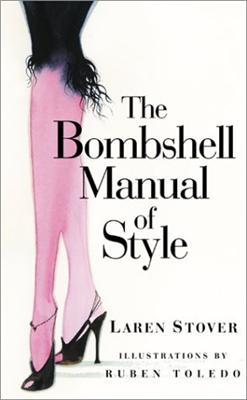
I’ve decided to part with my copy of The Bombshell Manual of Style, by Laren Stover (Ruben Toledo, Illustrator). This hardcover with dust jacket is in like-new shape, and sex kittens, vamps, etc. will enjoy it.
In a previous review, I wrote this of the book:
A fast fun romp through the lives of bombshells. No so much on the ‘how tos’ of makeup or fashion, but a funny & fresh look at what makes a girl glam! Covers excuses, words to live by and how to throw a tantrum – you know, the stuff you really want to know. A great book for reading as you soak in a champagne bubble bath!
There are many ways to enter…
* Follow me on Twitter: @DPopTart. (Please leave your Twitter username in your comment so I can check.)
and/or
* Tweet the following:
I entered @DPopTart’s contest to win a FREE copy of The Bombshell Manual Of Style http://t.co/vJp33Va
(Remember to come back here and leave a comment with your tweet for me to verify.)
You may tweet your entry once a day.
and/or
* Friend me on Face Book: Deanna Dahlsad. (When making the request, note that you are entering the contest.)
and/or
* Post about this contest at your blog or website — if you do this you must include in your post to this contest post or Kitsch Slapped in general.
(Please include the link to your blog post in the comments section so that I can find your post.)
and/or
* Post your entry as a comment — if you do this, please make sure I’ve got your email address, because if you’re the winner I’ll need your email address to contact you regarding your shipping information.
Here’s the giveaway fine print:
* Giveaway is open to US residents only
* Be sure that you leave your email so that I can contact you
* Contest ends September 15, 2011; entries must be made on or before midnight, central time, September 14, 2011. Winner will be announced/contacted on September 16, 2011. Winner has 48 hours to respond; otherwise, I’ll draw another name.
Have Hairdryer, Will Travel
This vintage travel photo is awesome on its own, but it’s also a culmination of many posts I’ve made today! (Hint: That means all but one of the the links are to my posts at other blogs. It will be like you traveling with me!)
Life magazine posted it at Tumblr, saying:
Hostel? Clean? Those two words in the same sentence? Wow, what a foreign concept for many of us— let’s take a trip back to When Hostels Were Clean (yes, once upon a time they were clean…)
We want to hear from you: tell us about your worst hostel experience.
I don’t think this is a true hostel; it looks like a motel. I would also accept the inaccurate use of hotel. But not a hostel. It’s not just my experience which says so; I look at a lot of (and post a lot) of vintage travel images. But in any case, note how mom has her portable hairdryer in hand. Americans probably wouldn’t bother to bring a hairdryer to a hostel… However, you would bring one before you bring a child.
Speaking of vintage hairdryers…
Traveling with one is preferred over packing your vacuum. Even if it can clean and double as a hairdryer.
Anyway, I’m lovin’ following Life at Tumblr (this is me at Tumblr, in case you wanna follow me there); I also posted this about Life’s contest tomorrow.
Literary Debutante Ball Fashion Advice: Etiquette Advice We Can All Actually Use
“For attractive lips, speak words of kindness. For lovely eyes, seek out the good in people. For a slim figure, share your food with the hungry. For beautiful hair, let a child run his/her fingers through it once a day.” – Audrey Hepburn. I would add: then take a shower, eat a hoagie and throw some lip-gloss on, because no one wants to be the starving, bleeding-lipped weirdo with kid junk in her hair.
From Marie-Helene Bertino’s Literary Debutante Ball Fashion Advice, where she also gives this wise nugget:
“Stop talking about your phone.” – One Clue to Becoming an Interesting Person, Marie-Helene Bertino
Amen.
And, for those not yet an interesting person, this would include iPads, laptops, book-readers, tablets and other tech gadgets. Wait to be asked — and even then, keep it short.
Image via Vicki @ Nostalgic Collections.
Lashes For The Feminist Movement
Picture the scene… It’s 1974 and those women’s libbers are everywhere. Before you know it, those damn women will have screwed up everything. Hell, we won’t even be able to tell the boys from the girls. Oh my gawd, what about the children?! How do you combat it? Big Fluttery Lashes.
The amazingly-trademarked Big Fluttery Lashes were copyrighted in 1974, by Imagineering Inc., Phoenix, Arizona (but made in Hong Kong). The lashes sold for 39 cents and they were safe & non-toxic (unless you’re under the age of three).
And good news, boys; if you were caught with one on your upper lip (or simply caught with the package), you could simply say it was a mustache — the package even says so!
Image via Tiki Ranch.
“Give Your Wife An Extra Head For Chirstmas”
An ad from 1969 that likely couldn’t be published today:
OK, so it reads “an extra head,” not just “extra head” or just plain old “head,” but still, ad execs today would just know what we’d be reading into the buzzing gift of a Lady Remington.
Lady Remingtons, by the way, were quite popular gifts, judging by the number of them found at garage sales, thrift stores, etc. So this ad may have sent just the right message after all. *wink*
Marjorie Hellen: “Identification Girl” The Ultimate Objectification Or Not?
Featured on the cover of People Today, September 22, 1954, was “Marjorie Hellen… TV’s Golden Girl.”
Her story begins on page 55, filed under “People In TV,” Hellen’s story is titled She’s ‘Compatible’ Marjorie Hellen Is Strawberry Blond Trade-Mark on Color TV.
If that’s not intriguing enough, check out the caption under the photo: “Marjorie And Her Rival Black-And-White Test Pattern (rear)”.
From the article:
Millions of NBC-TV viewers are getting slightly frustrated whenever the smiling image of lovely Marjorie Hellen flashes on their black-and-white screens with her quiet announcement: “The following program…will be broadcast in color …” The reason: Around 10,000 TV sets in the U.S., costing between $495 and $1,100, are showing the same girl as she appears on PEOPLE TODAY’S cover–gray-eyed, strawberry blond.
Marjorie, who doubles as a live test pattern for sensitive color cameras, is the “identification girl” for NBC Color TV, which has scheduled 39 90-minute “spectaculars” for its compatible system (the shows can also be received in black-and-white) during 1954-1955.
The article credits “an attack of anemia” for Hellen getting the gig — not specifically for her coloring (though only her doctor knows for sure), but for her availability:
It kept her from going to school, made her available when Claude Traverse, manager of NBC’s color unit, selected her from photos as having the “ideal flesh tone” for lining up color cameras.
Hellen may be more familiar to you as Leslie Parrish; she changed her name in 1959.
Beauty Kills
As the seller of this vintage 357 Magnum Hair Dryer correctly states, this gun and holster blow dryer might just be the “most misogynistic appliance” ever. Or at least the most misogynistic beauty appliance. Just pull the hammer on the pistol and blow your brains hair out. (If you don’t like the price, $225, search for Jerdon Magnum hair dryers at eBay.)
British Ladies Cat Fight With American Women, 1832
Since I love old beauty tips and their cultural context, I was intrigued by A Slip of a Girl’s posts sharing clippings from the March 1831 issue of Atkinson’s Casket (aka The Casket). In that same issue, found via Google Books, I found this great article on painting on glass — but I wanted more.
In another issue, from 1832, this incredible review of Frances Trollope‘s Domestic Manners of the Americans (1832):
Mrs. Trollope has treated America with the same liberality, and her success in depicting the character of our people, has been nearly as great as captain Hall’s. An unsuccessful speculation in Cincinnati, awakened, it appears, the indignation of Madame T. and she forthwith—with the assistance of the notorious Fanny Wright, with whom she travelled, and whose abominable doctrines she appears to have imbibed—resolved to glut her revenge by writing a book. No doubt she is now satisfied, for she has the pleasure of seeing it stated in print, sanctioned by her name, that the Americana are the most illnatured, ungenerous, wicked, illiterate and vulgar people on the face of the earth ; that their moral sentiment is less elevated than that of the savages, and that the half-horse and half-alligator population of the Mississippi Valley, are as uncouth and as barbarous as a nation of Ourangutangs.
Mrs. Trollope, however, certainly unwittingly, pays American ladies, a very high compliment. Having fixed upon the society of Almacks as the criterion by which to examine the character of our ladies, she finds that they are all utterly destitute of polish; of that easy, lady like deportment, by which English ladies are distinguished throughput the world, and entirely ignorant of those amiable accomplishments in maneuvering, &c. which give her own countrywomen so strong an influence over their husbands. Our ladies are too modest in their behaviour and dress, to meet the views of Mrs. T. ; in company they want loquacity ; they seldom visit theatres; they arc respectful to their husbands, and indefatigable in instructing their children ; they are but indifferent dancers, and speak Italian shockingly incorrect ; and finally they are not carried away with foolish and ridiculous fashions. All these are serious faults in the opinion of the immaculate Trollope, and she vents her spleen at them in no measured terms.
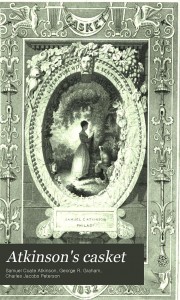 Trollope’s sentiments seem very much to echo those of this article from 1907 — so much so, that I double-checked that Trollope was indeed deceased in 1863. However, as this article, titled British Cockney Writers, shows, this apparently was quite the trend during this period.
Trollope’s sentiments seem very much to echo those of this article from 1907 — so much so, that I double-checked that Trollope was indeed deceased in 1863. However, as this article, titled British Cockney Writers, shows, this apparently was quite the trend during this period.
Included in this issue of Atkinson’s Casket are some excerpts or “extracts” — of which I found the following quite amusing:
The ladies have strange ways of adding to their charms. They powder themselves immoderately, face, neck, and arms, with pulverised starch; the effect is indescribably disagreeable by daylight, and not very favorable at any time. They are also most unhappily partial to false hair,which they wear in surprising quantities; this is the more to be lamented, as they generally have very fine hair of their own. I suspect this fashion to arise from an indolent mode of making their toilette, and from accomplished ladies’ maids not being very abundant; it is less trouble to append a bunch of waving curls here, there and every where, than to keep their native tresses in perfect order.
Though the expense of the ladies’ dress greatly exceeds, in proportion to their generalstyle of living, that of the ladies of Europe, it is very far (excepting in Philadelphia) from being |n good taste. They do not consult the seasons in tne colors, or in the style of their costume; 1 have often shivered at seeing a young beauty picking her way through the snow with a pale rose-colored bonnet, set on the very top of her head: I knew one young lady whose pretty little ear was actually frost-bitten from being thus exposed.— They never wear muffs or boots, and appear extremely shocked at the sight of comfortaole walking shoes, and cotton stockings, even when they have to step to their sleighs over ice and snow.
They walk in the middle of winter with their poor little toes pinched into a miniature slipper, incapable of excluding as much moisture as might bedew a primrose. I must say in their excuse, however, that they have, almost universally, extremely pretty feet. They do not walk well, nor, in fact, do they ever appear to advantage when in movement. I know not why this should be, for they have abundance of French dancing masters among them, but somehow or other it is the fact. I fancied I could often trace a mixture of affectation and of shyness in their little mincing unsteady step, and the ever changing position of the hands. They do not dance well; perhaps 1 should rather say, they do not look well when dancing; lovely as their faces arc, they cannot, in a position that exhibits the whole person, atone for the want of tournun-. and for the universal defect in the formation of the bust, which is rarely full, or gracefully formed.
PS Apparently this had all been previously published in The Saturday Evening Post; the connections between and history of The Casket and The Saturday Evening Post are well documented here.
Breaking Free Is A Drag (Or, Drag Queens Part 1)
Glowing Doll Danielle says she was “totally gob smacked” watching Freddie Mercury’s “sexy mustachioed housewife” in Queen’s I Want To Break Free.
In her post, Danielle also wrote:
I love drag queens because they can dress like women but without all of the pressure to look pretty or be sexy. I know there are plenty of women who dress like drag queens but they are few and far between and they tend to be Pop stars.
Umm, I could be wrong here, but I’m pretty sure the sole point of being a drag queen is to look pretty and be the (supposed) feminine ideal of sexy.
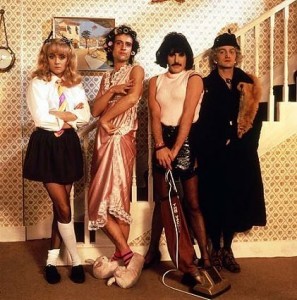 I think part of Danielle’s confusion here — and there’s plenty to be confused about traversing those fine, slinky, and slippery lines between drag queens, female impersonators, transgendered folk, cross dressers, fetishists, etc. (note: no mention of gay folk here) — is mistaking Mercury’s artistic gender-bender performance for Mercury being a drag queen.
I think part of Danielle’s confusion here — and there’s plenty to be confused about traversing those fine, slinky, and slippery lines between drag queens, female impersonators, transgendered folk, cross dressers, fetishists, etc. (note: no mention of gay folk here) — is mistaking Mercury’s artistic gender-bender performance for Mercury being a drag queen.
Freddie Mercury in drag is not Freddie Mercury, Drag Queen.
The simple & pure existence of a mustache sort of illustrates that point — and my point about a boundary pushing performance.
Danielle gets close to those distinctions when she writes the following (exactly as typed at her blog):
To me anyway, Drag culture is as much about attitude as it is about aesthetic. It seems to exude a sort of ‘Don’t give a fuck’ attitude which I think everyone could benefit from. Ultimately there is a humour born from sadness underlying the aesthetic. The theatricality used as a kind of armour against a world that is so un accepting of others.
If I could be a part of either world I just feel that I would be freer some how. I find myself, inpsite of a vast collection of clothes and accessories, dressing drably from day to day. I guess I fear judegement by small minded people and on a deeper level just want to dissapear sometimes (hard to do with electric coloured clothes, spiked accesories and gigantic hats).
The mythical non-mustached Drag Queen Mercury, like other Drag Queens, probably would have had a female name and completely distinct female persona to go with it. And none would have seen drag as an armor but as flamboyant exhibitionist expression — that people would still sling arrows at.
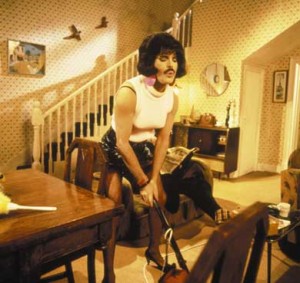 Mercury in drag wasn’t exactly like Travolta in Hairspray; Mercury’s dress was a theatrical application, use of imagery to make a point. Or at least a slightly different point. And the whole point of Freddie Mercury et al and their obvious appearance as men in women’s clothing (along with other things in this video and aspects of Mercury’s life) was to expose absurdity, especially the norms of “normal,” to break free of everything — everything except that vacuum, that is. *wink*
Mercury in drag wasn’t exactly like Travolta in Hairspray; Mercury’s dress was a theatrical application, use of imagery to make a point. Or at least a slightly different point. And the whole point of Freddie Mercury et al and their obvious appearance as men in women’s clothing (along with other things in this video and aspects of Mercury’s life) was to expose absurdity, especially the norms of “normal,” to break free of everything — everything except that vacuum, that is. *wink*
After Stocking Panic, Women Made-Up
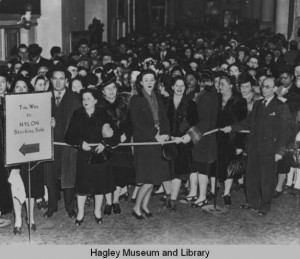 I’ve researched and written a lot about vintage nylon stockings over the years because the history of nylon stockings is quite fascinating to me. I’m sure most of you have heard about the scarcity of nylon during WWII — just months after the new invention hit store shelves on May 15, 1940. Even silk stockings, second choice to the preferred fit and feel of nylon, were in very short supply as silk was also used for the war effort and the war itself interfered with over-seas shipments.
I’ve researched and written a lot about vintage nylon stockings over the years because the history of nylon stockings is quite fascinating to me. I’m sure most of you have heard about the scarcity of nylon during WWII — just months after the new invention hit store shelves on May 15, 1940. Even silk stockings, second choice to the preferred fit and feel of nylon, were in very short supply as silk was also used for the war effort and the war itself interfered with over-seas shipments.
The inability to get stockings fueled “Nylon Mania” and caused “Stocking Panic.” These terms are not flowery exaggerations. When shipments of stockings were announced, long lines and even mobs formed. It was so common place, jokes and cartoon strips about Nylon Mania abounded.
Women (and stocking-loving males) everywhere in the country were saying they’d kill for a pair of stockings; whether or not any of them actually did isn’t out of the realm of possibility… People weren’t always content to wait for stockings to arrive in stores, then form and wait in long lines to buy them. They formed mobs, sometimes attacking other shoppers; stockings (which retailed for about a dollar) sold for as much as $20 (that’s a month’s worth of payday loans back then) on the black market, which only incentivised robberies and other crimes. So commonplace was this mania, so connected to criminal activity, that in Chicago, police investigating a murder case used “Nylon Mania” to rule out robbery as motive simply because six pairs of nylon stockings ($120 worth of valuable property) had been left at the scene of the crime.
This is why you often hear jokes about guys getting “in” with a girl by bringing her stockings; like chocolates & cigarettes, stockings were such a luxury that they might buy you things that money might not!
Some of you may have been told by a relative, or otherwise heard about, how women during World War II had no stockings and so they ‘penciled in’ seams, using eyeliner or eyebrow pencil to draw lines up the backs of their legs to create the look of stockings. Here, 1942 Hollywood starlet Kay Bensel applied her faux stocking seams with a device “made from a screw driver handle, bicycle leg-clip, and an ordinary eyebrow pencil.”
But apparently this was not the only cosmetic approach to hiding one’s bare legs with Victory Hose. In a copy of The Professional Beautician (June, 1942), I found an ad which surprised me (I may surprise many of you with my finds, but many things continue to surprise me too!); an ad for beauty shop owners to stock Curley Colortone Cosmetic Stockings:
The vintage wholesale advertisement for professionals promises that each unit of Curley Colortone Cosmetic Stockings includes a jar of Colortone (in all popular shades) and a jar of Curley Foundation Creme (to give complete perfection) and clearly shows that salon product was also available. While not the graphic feast for public promotion this 1943 ad for Gaby Nu-Natural leg make-up is, I do have the Curley Colortone ad to thank for informing me about such vintage beauty products.
But don’t get too excited thinking these products were simply a matter of the war (or get overly upset thinking that companies dared to capitalize off of the war) because the January 1938 issue of Popular Science boasted “Cream Replaces Silk Stockings,” a new cosmetic “boon to the outdoor girl,” (who I suppose didn’t want to damage silk stockings with snags on twigs and other outdoorsy things). And in fact, the Smithsonian, showing us Leg Silque Liquid Stockings by the Langlors Company, says that such leg makeup had been available since the 1920s — but “it wasn’t until rationing was introduced during the World War II that the product became an essential commodity for many American women.” Heck, by then even Hollywood was impacted; unable to get stockings for the gams of their actresses and starlets, Hollywood created its own makeup stocking substitute.
This all brings us to another WWII joke:
Q: What’s a wife more afraid of finding on her man than lipstick on his collar?
A: Leg paint on his back.
PS American women weren’t the only ones suffering either; Miner’s had great success with its Seam Stick and Miner’s Liquid Stockings.
Does Makeup Keep You From Getting Laid? (Or, When He Professes He Likes The ‘Natural’ Look)
Don’t you just hate it when your man turns to you and says, “I like you better without make-up,” or makes some comment about how he “prefers the natural look” — and you remember how you looked when you met, all dolled-up. You (and I) know that he was drawn to you for how you looked that night… His lust was written all over his face — in his own drool! Yet here is now, acting like that never ever happened. Infuriating, isn’t it?
So just what is the deal, anyway?
Is he complaining about the artifice because he feels tricked? No, not if he’s been with you for months, treating you like a queen, married you; he’s already gotten over you, your morning face, and the fact that your push-up bra is a devilish bit of engineering and your lips aren’t naturally that rosy.
Is this his way of making you less attractive to other guys? Well, I can’t rule that possibility in or out without knowing more… Some controlling guys do do that. But I can tell you what I know.
Fact: Men are naturally, biologically, attracted to beauty. So when they say they don’t like the ‘unnatural’ beauty what they are really saying is that they don’t like living with it. And not because they aren’t man enough to shave at the same sink where pink lipstick sits.
Sure, men see you all dolled-up and are attracted to it, but that’s more of an unconscious thing, a perception; their complaints are based on more direct and palpable experiences.
Think back to your own first experiences with makeup… Remember when you first put on that Chapstick, Bonnie Bell Lipsmacker, gloss or lipstick? You sure could feel the pure petroleum, the carnauba wax, and whatever else puts the Eeeiiww in eeeiiww-mollients. It took some time getting used to… But you put up with it for the attention you got. Men (at least the complaining sort) don’t find any perks for dealing with it and just plain don’t want to get used to it.
Some guys will accept a girl who is high-maintenance because she’s needy, neurotic or controlling longer than they will a high-maintenance glamour girl, simply because it’s a lot easier for them to avoid the emotional sticky-stuff than it is the unappealing tactile issues of cosmetic goo.
So just how does a woman balance the application of makeup to highlight her features and be desirable yet remain touchable?
For help I enlisted the help of some other women who make their livings off of being attractive to men: sex workers. Yup, I asked strippers, escorts, and call girls for some beauty advice. I figured they’d be the ones to know.
(I shouldn’t have to say this, but many people are paranoid when it comes to sex workers, so I will. No one is stating or implying that men seek the services of a sex worker simply due to makeup issues; those reasons are far more complicated. No one is making the comparison between the use of cosmetics and being a whore; so-called ‘painted ladies’ are everywhere now. And, for the record, not all sex work is illegal; and let’s not get all tied up in the ‘morality debate’ — today anyway. This is just about working girls sharing how they work the makeup.)
Beauty Tips From Sex Workers
When it comes to make-up, less is definitely more. You want to create “come hither,” but not “look, don’t touch!” So don’t go the model route, with layers of concealers, color correctors, foundation, lip liner, filler, and stains. You’re not posing for hours here, looking aloof and untouchable, so don’t create any unnecessary barriers to being touched.
If you don’t want to discourage the nooners, that potential kiss at the office, or you just don’t want to wake-up scary (plus sleeping in makeup does bad things to your eyes and skin), the old K.I.S.S. — Keep It Simple Stupid — really does apply to makeup application.
Skip the foundations; just use a sunblock and powder. If you insist, blusher. And if you’ve got a blemish or two, just dab on a concealer (or concealing zit treatment) before you powder.
Keep your eye makeup simple too. The most natural eyeshadow color is a violet or mauve — these are shades naturally found it most every complexion, believe it or not (think of the tint blood vessels give the thin skin on the eyelid) so they look the least like “make-up.”
Either use waterproof mascara that will last; or one that is super easily removed (with soap & water or baby wipes — very portable!). Several of these sex workers also said that they ‘cheated’ by using mascara as a liner, using the tip of the applicator to line at the base of the eyelashes. It gives a less noticeable line and it stays put longer than eye liners.
Do not ever line the inside of your eyes with liner. Not only does it actually make your eyes appear smaller, but it’s not good for your eyes and it always goos-up in the corners of your eyes. Not a good look for intimate situations, when he’s taking in your every little detail.
Powder, powder, powder! Use a light application of loose powder to set everything from your blusher to your eyeliner and eyeshadow. Your makeup will wear longer, rub off less, yet it’s easily removed when you want to take it off.
Lipstick: Red lips work. Get a really good sheer red lipstick (One worker specifically noted some shades: “I love Lauder’s Sheer Cherry, though I think that color’s not regularly sold anymore; look for it in the Gift With Purchase sets and seasonal sets. And Avon’s Slick Tint in Glossy Wine is fab!”). If you keep your lips exfoliated (easy to do when you wash your face by gently rubbing your lips with a wet washcloth), you can use a liner to fill in your lips beneath the for extra vibrancy and longer staying power — but if your lips tend to be dry, beware how dry the liner will make your lips look if you blot your lipstick off. Of course, if the skin around your lips is very dry, avoid reds and other bright colors as they bleed and make a mess even before you kiss.
(Of course, there are plenty of guys who get-off on smeared makeup — especially when your eyes tear from err, taking it deep & gagging. But these aren’t the guys who are going to complain that you’re too made up!)
Some men are extremely sensitive to scents & smells and you might be surprised just how many smells there are on you when you’re using beauty products — especially when things heat up and scents start to rise into the air. Take it from the women who make a living off of men who don’t want to go home smelling like another woman: avoid lots of scents. Look for ‘sensitive skin’ beauty & skin care products as one of the first things they remove are the perfumes and masking scents. This includes your skin care, your shampoo, your body care products too.
Men don’t like hair they can’t touch. Generally speaking, they want to pull your pony during doggy; not get slapped by you for mussing the ‘do or harming a weave.
Oh, and finger nails! Sure, long nails are pretty in faux lesbian porn, but generous men worry that you won’t be able to rub-out your own orgasm, voyeurs worry they won’t be able to watch it, selfish or quick guys know theire days (and nights) are numbered, and very few men want to see a dragon lady nail going for their prostrate! (One escort noted, “I compromise and have 9 long ones, keeping ‘the shocker’ short.”)
Now that he’s taken you up on the come-hither-offer, it’s time for clean-up. You know that furtive post-coitus pee you take (or at least you should be taking it — urinating after sex helps wash away bacteria; otherwise you risk urinary tract infections) — use that to fix makeup smudges or wash it off entirely and reapply it in minutes. You’ll look as fresh as a daisy — that’s just been plucked!
If you follow these tips, you likely won’t hear him complain about makeup anymore. (But don’t blame me if he can’t keep his hands off you!)
